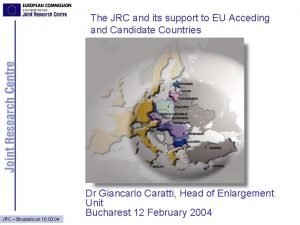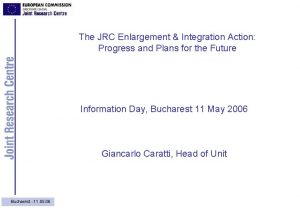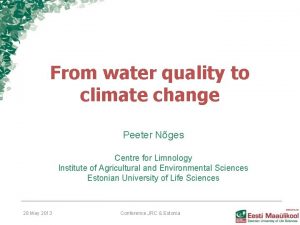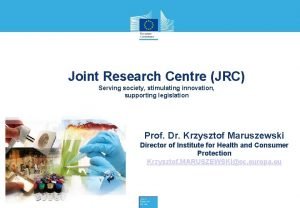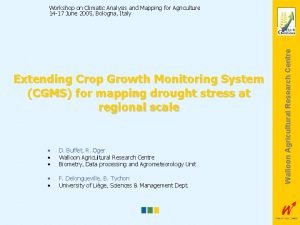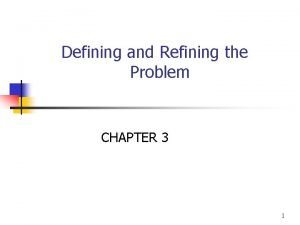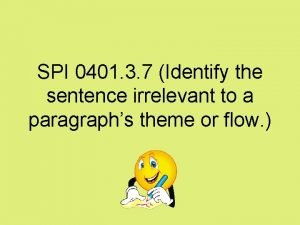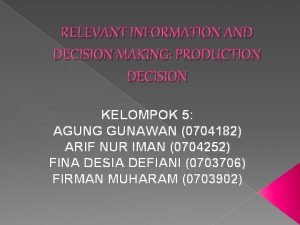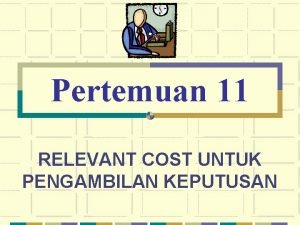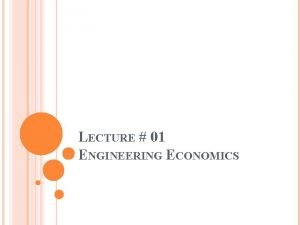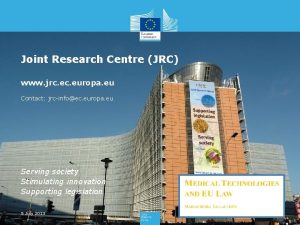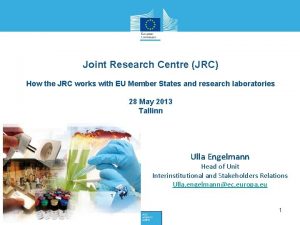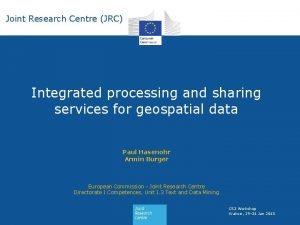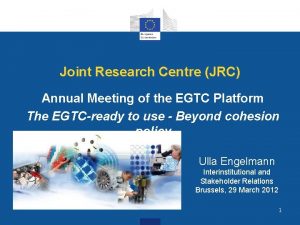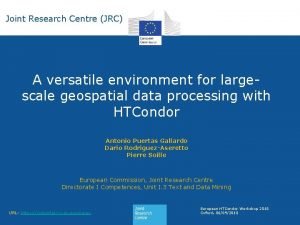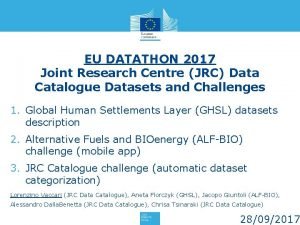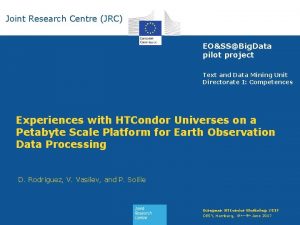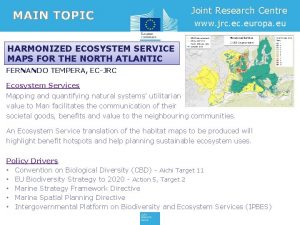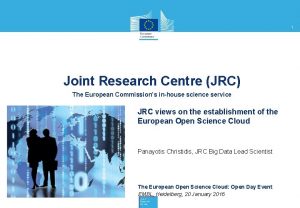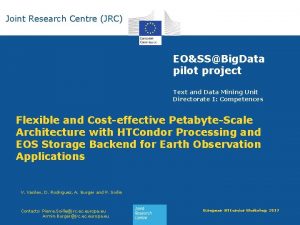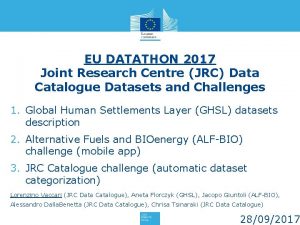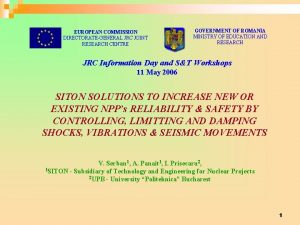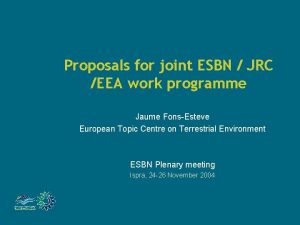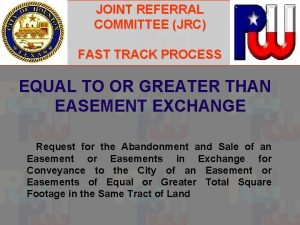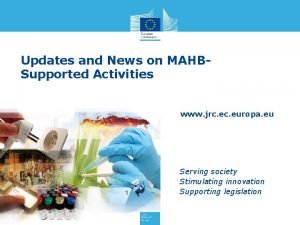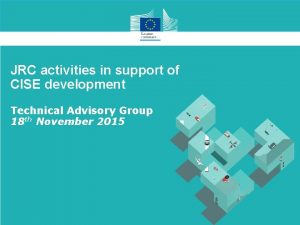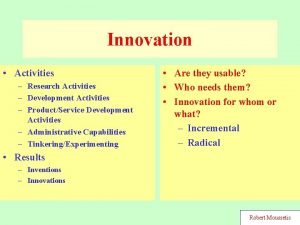Activities of the Joint Research Centre JRC relevant























- Slides: 23

Activities of the Joint Research Centre (JRC) relevant for the assessment of spatial development in Europe Contact : Carlo Lavalle Joint Research Centre of the EC Institute for Environment and Sustainability Land Management Unit Ph: **39 0332 785231; Fax: **39 0332 789085 E-mail : carlo. lavalle@jrc. it

Institutional Framework Court of Auditors Committee of the Regions European Parliament Court of Justice IND. TRADE Council of Ministers Economic and Social Committee European Commission INFOR. RESEAR CH JRC ENVI. AGRI EUROSTAT Commissioner of Research EI IPSC IRMM IAM Institute for Environment and Sustainability IHCP ITU IPTS REGIO

Summary of Activities · MOLAND : Monitoring land cover/use dynamics for sustainable urban and regional development · NATURAL HAZARD : Protection of the environment and the citizens against floods (LISFLOOD) and forest fires · ESDI : European Spatial Data Infrastructure · Agri-environmental Indicators – Landscape characterisation

MOLAND (Monitoring Land use/cover Dynamics) Towards Sustainable Urban and Regional Development Contact : Carlo Lavalle Joint Research Centre of the EC Institute for Environment and Sustainability Land Management Unit Ph: **39 0332 785231; Fax: **39 0332 789085 E-mail : carlo. lavalle@jrc. it Web : http: //moland. jrc. it

MOLAND: Towards sustainable urban and regional development Aim: • Provide a methodology to assess, monitor and forecast the (sustainable) development of urban and regional environments at EU level Specific applications: • Assessment of sustainable urban and regional development: § Definition and computation of territorially-based indicators to allow integrated approaches § Development of scenarios for long-term strategies of sustainable development • Evaluate and compare alternative scenarios of spatial planning (land-use) and policy • Determine the critical factors in the input spatial plans and policies • Assessment and evaluation of policies with territorial impact: • Application of the methodology for impact assessment of Regional Development interventions (SF, Cohesion Funds, CI) § Introduction of Strategic Environmental Assessment concepts and tools in urban / regional planning § Complementing the ESPON Research Programme § Networking with local/regional/national authorities

MOLAND : Study Areas in Europe

MOLAND : The Methodology Three inter-linked components: 1. Database preparation (CHANGE): - Measure past and present land use evolution in selected areas (urban, region, corridor, …) • • • The reference (current) land use database is derived typically for 1998 -2000. The historical database is computed with data from time windows in mid ’ 50, end of ’ 60, and ’ 80 (only 2 dates for larger areas). Statistics and socio-economic datasets are merged into the GIS 2. Development of indicators (UNDERSTAND): Identification and computation of territorial and sustainable development indicators to provide a synthetic assessment of urban and regional landscapes. • Static and dynamic environmental indicators comparable across Europe 3. Development of scenarios (FORECAST): related to urban evolution and assess sustainability of regions • • forecasting future land use development and its impact on environment, under alternative spatial planning and policy scenarios develop scenarios of growth to formulate and evaluate long term strategy for sustainable development.

MOLAND : The methodology CHANGE UNDERSTAND FORECAST 1960 1948 1997 1981 Land use evolution Statistics and trends 2010 Scenarios of future evolutions Statistical data (demography, transport, socio-economic, etc. ) Integrated territorial indicators

MOLAND – UNDERSTAND: Indicators for urban and regional development · Land use indicators · Urban sprawl · Soil Sealing · Fragmentation indices · Urban/Regional development integrated indicators · European Common Indicators · Strategic Environmental Assessment of TEN/T

Moland – Examples of indicators Access to green areas (Copenhagen) Green edge Habitat suitability Potential noise pollution (Dublin) (Munich) Urban sprawl Land use transformation Road network density Industr. /Comm growth 1 9 4 8 1 9 6 0 1 9 8 1 (Grenoble) (Trans-border Alpine site) Commuters vs land use (Dresden) Population Growth and location Urban Growth Comparative analysis Impact of transport corridor 1 9 9 7

Publication of first results Towards an urban atlas Assessment of spatial data on 25 European cities and urban areas. Environmental Issue Report No. 30 Office for Official Publications of the European Communities, Luxembourg. ISBN 92 -9167 -470 -2. 131 pp. Joint publication of European Environment Agency and European Commission – DG Joint Research Centre. Available on-line at: http: //moland. jrc. it or: http: //www. eea. eu. int/

MOLAND – FORECAST - Method Economic Activities Employment Housing demand Inter-regional migration Transport flows Land use demand Land use (2025) Spatial planning and policy recommendations and guidelines

MOLAND – Next Steps • Support to the definition of the Urban Thematic Strategy § Chair of the Working Group on Sustainable Urban Management § Creation of a network of cities/regions § Development of scenarios of urban growth at EU dimension § To validate EU policies ( territorial diversity) • Formalise the methodology in the ‘regional policy’ frame § Impact evaluation of Structural Programmes (ERDF, Cohesion, CI, …) § Pilot project in Northern Ireland/Ireland § ESPON -> Moland in the Work Programme § SEA concepts in regional planning § Integrated modeling for concepts such as Peripherality/accessibility/… § An EU ‘artificial layer’ from CORINE 2000 ( at scale 1: 25 000) (proposal) § Concept of “dynamic indicators” § City <=> region (carrying capacity and functional area)

NATURAL HAZARD Contacts: guido. schmuck@jrc. it (natural hazards project leader) ad. de-roo@jrc. it (flood & water activities) jesus. san-miguel@jrc. it (forest fires) http: //natural-hazards. jrc. it

Natural Hazards Forest Fires: Processing chain to develop forest fire risk indices Structural Risk index Dynamic index: vegetation status, meteorological observations Advanced fire risk index based on the integration of all indices Processing chain for burnt area mapping and fire damage assessment Floods: Flood simulation modelling system for impact assessment Processing chain for flood extend mapping and damage assessment Flood risk maps Pre-operational system for Flood-watch European Flood Forecasting System

FLOOD - Main Activities · Development of LISFLOOD modelling system ð ð ð large catchments: Oder, Meuse small catchments: Oder-subc, Meuse-subc, Toce Europe (1 km grid) (100 m grid) (5 km grid) · Simulation of land-use scenario on flood and water balance ð Flood prevention scenario case-studies § § Oder (IKSO / Oder-LISFLOOD; Oder. Regio / INTERREG) Meuse (Meuse Water Authority) Elbe & Danube (foreseen for 2003/2004) Other European Transnational basins (foreseen for 2005 -2006) · European Flood Forecasting System ð ð ð Flood pre-warning and flood risk Flood extent and damage forecasting Realtime tests already done: Oder (2001), Elbe & Danube (2002) · Contribution to Catchment Information System

The LISFLOOD modelling system · · LISFLOOD-WB LISFLOOD-FS LISFLOOD-FF LISFLOOD-FP Catchment-scale Water balance model Flood simulation model Flood forecasting model Flood Inundation model Floodplain-scale

LISFLOOD outputs Discharge Evapotranspiration – time series Water Source Areas Evapotranspiration Soil moisture storage Capacity

EUROPEAN FLOOD FORECASTING SYSTEM (EFFS) 10 day weather forecasts: rainfall temperature + discharge forecast Flood forecasts for all major rivers: LISFLOOD MODEL 10 -day forecast Meuse: 20 -30 January 1995 with uncertainty range Example of a warning report

European Forest Fire Risk Forecasting System (EFFRFS)

FIRE POTENTIAL INDEX Structural Risk Vegetation Stress Risk Meteorological Risk Fire Potential Index

BURNT AREA AND DAMAGE ASSESSMENT: PORTUGAL 2000

European Forest Fire Information System EFFIS Modules Fire Risk Burnt Areas Products: • Cartography Regeneration Risk zoning Biomass CO 2 emiss. • Tables • Statistics Customer and user: EP Member States EC
 Jrc
Jrc Jrc
Jrc Jrc
Jrc Jrc annual report
Jrc annual report Jrc global buffet
Jrc global buffet Refine the problem
Refine the problem Centroid problems engineering mechanics
Centroid problems engineering mechanics Centroid of gravity
Centroid of gravity Operating activities vs investing activities
Operating activities vs investing activities Outdoor and indoor sports
Outdoor and indoor sports Support activities and primary activities
Support activities and primary activities Definition of primary activities
Definition of primary activities Cutability
Cutability What type of joint is the intervertebral joint
What type of joint is the intervertebral joint Semi permanent joints
Semi permanent joints Appretaite
Appretaite Lamb grading chart
Lamb grading chart Fibrous joints
Fibrous joints Sentence for irrelevant
Sentence for irrelevant Decision making and relevant information
Decision making and relevant information Relevant cost adalah
Relevant cost adalah Five step decision making process
Five step decision making process Consider all relevant criteria
Consider all relevant criteria Culturally responsive vs culturally relevant
Culturally responsive vs culturally relevant
